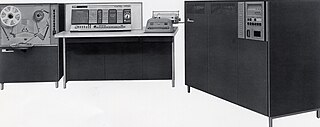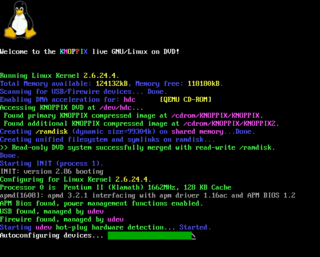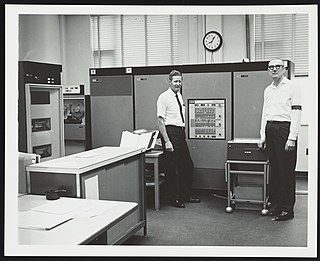
The IBM 3270 is a family of block oriented display and printer computer terminals introduced by IBM in 1971 and normally used to communicate with IBM mainframes. The 3270 was the successor to the IBM 2260 display terminal. Due to the text color on the original models, these terminals are informally known as green screen terminals. Unlike a character-oriented terminal, the 3270 minimizes the number of I/O interrupts required by transferring large blocks of data known as data streams, and uses a high speed proprietary communications interface, using coaxial cable.

A programmable logic controller (PLC) or programmable controller is an industrial computer that has been ruggedized and adapted for the control of manufacturing processes, such as assembly lines, machines, robotic devices, or any activity that requires high reliability, ease of programming, and process fault diagnosis.

A sound card is an internal expansion card that provides input and output of audio signals to and from a computer under the control of computer programs. The term sound card is also applied to external audio interfaces used for professional audio applications.

In electronics, a multiplexer, also known as a data selector, is a device that selects between several analog or digital input signals and forwards the selected input to a single output line. The selection is directed by a separate set of digital inputs known as select lines. A multiplexer of inputs has select lines, which are used to select which input line to send to the output.

In telecommunications and computer networking, multiplexing is a method by which multiple analog or digital signals are combined into one signal over a shared medium. The aim is to share a scarce resource – a physical transmission medium. For example, in telecommunications, several telephone calls may be carried using one wire. Multiplexing originated in telegraphy in the 1870s, and is now widely applied in communications. In telephony, George Owen Squier is credited with the development of telephone carrier multiplexing in 1910.

The IBM 1710 was a process control system that IBM introduced in March 1961. It used either a 1620 I or a 1620 II Computer and specialized I/O devices.

Data acquisition is the process of sampling signals that measure real-world physical conditions and converting the resulting samples into digital numeric values that can be manipulated by a computer. Data acquisition systems, abbreviated by the acronyms DAS,DAQ, or DAU, typically convert analog waveforms into digital values for processing. The components of data acquisition systems include:

A computer terminal is an electronic or electromechanical hardware device that can be used for entering data into, and transcribing data from, a computer or a computing system. The teletype was an example of an early-day hard-copy terminal and predated the use of a computer screen by decades. Starting in the mid-1970s with machines such as the Sphere 1, Sol-20, and Apple I, terminal circuitry began to be integrated into personal and workstation computer systems, with the computer handling character generation and outputting to a CRT display such as a computer monitor or, sometimes, a consumer TV.

One meaning of system console, computer console, root console, operator's console, or simply console is the text entry and display device for system administration messages, particularly those from the BIOS or boot loader, the kernel, from the init system and from the system logger. It is a physical device consisting of a keyboard and a printer or screen, and traditionally is a text terminal, but may also be a graphical terminal. System consoles are generalized to computer terminals, which are abstracted respectively by virtual consoles and terminal emulators. Today communication with system consoles is generally done abstractly, via the standard streams, but there may be system-specific interfaces, for example those used by the system kernel.

The IBM 1800 Data Acquisition and Control System (DACS) was a process control variant of the IBM 1130 with two extra instructions, extra I/O capabilities, 'selector channel like' cycle-stealing capability and three hardware index registers.
The IBM 1711 Data Converter was part of the IBM 1710 process control computer. The 1711 contained an analog-to-digital converter that accepted signals from the IBM 1712 Multiplexer and Terminal Unit that were between -50 millivolts and +50 millivolts and converted them into signed, four decimal digit numbers that were stored in the 1710s core memory.
Power-system automation is the act of automatically controlling the power system via instrumentation and control devices. Substation automation refers to using data from Intelligent electronic devices (IED), control and automation capabilities within the substation, and control commands from remote users to control power-system devices.
In computing, channel I/O is a high-performance input/output (I/O) architecture that is implemented in various forms on a number of computer architectures, especially on mainframe computers. In the past, channels were generally implemented with custom devices, variously named channel, I/O processor, I/O controller, I/O synchronizer, or DMA controller.

A front-end processor (FEP), or a communications processor, is a small-sized computer which interfaces to the host computer a number of networks, such as SNA, or a number of peripheral devices, such as terminals, disk units, printers and tape units. Data is transferred between the host computer and the front-end processor using a high-speed parallel interface. The front-end processor communicates with peripheral devices using slower serial interfaces, usually also through communication networks. The purpose is to off-load from the host computer the work of managing the peripheral devices, transmitting and receiving messages, packet assembly and disassembly, error detection, and error correction. Two examples are the IBM 3705 Communications Controller and the Burroughs Data Communications Processor.
Direct digital control is the automated control of a condition or process by a digital device (computer). Direct digital control takes a centralized network-oriented approach. All instrumentation is gathered by various analog and digital converters which use the network to transport these signals to the central controller. The centralized computer then follows all of its production rules and causes actions to be sent via the same network to valves, actuators, and other heating, ventilating, and air conditioning components that can be adjusted.

The IBM System/7 was a computer system designed for industrial control, announced on October 28, 1970 and first shipped in 1971. It was a 16-bit machine and one of the first made by IBM to use novel semiconductor memory, instead of magnetic core memory conventional at that date.

A single-board microcontroller is a microcontroller built onto a single printed circuit board. This board provides all of the circuitry necessary for a useful control task: a microprocessor, I/O circuits, a clock generator, RAM, stored program memory and any necessary support ICs. The intention is that the board is immediately useful to an application developer, without requiring them to spend time and effort to develop controller hardware.

270x is a generic name for a family of IBM non-programmable communications controllers used with System/360 and System/370 computers.
IBM 1070 Process Communication System was IBM's communication system with analog-to-digital and digital-to-analog conversion functions that was announced in 1964 for the process industries.














